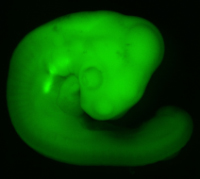Chicken
Although chickens (Gallus gallus) are not particularly suitable for genetic analysis, they are still seen as important model organisms for genetic and developmental studies.
Chickens have a long breeding cycle, of over six months, and produce few eggs, making it difficult and time-consuming to cross-breed them. It is therefore unsurprising that there are few mutant strains, although through transgenic techniques it is possible to produce genetically modified chickens.
Why study chickens?
Chickens are often used when birds are needed for a physiological study. They are easy to keep, and have been bred domestically for many years, so a large amount of literature on their physiology is available. They produce hardy embryos, whose development occurs outside the body of the mother. The shell of the chicken egg can be cut, and covered with clear plastic so that development of the chicken can be viewed at all stages. It is also possible to develop chick embryos in culture outside the egg.
Access to the embryo during development means that experiments involving surgical manipulation and chemicals which change the process of development are possible. Since studying the development of mammals is such a difficult process, the insights from these studies often provide useful comparative information.
Since chickens are vertebrates, their developmental process has a great deal in common with humans, despite the many differences. They have provided valuable insights into the development of the nervous system, showing how cells migrate and differentiate. They have also been used to discover the molecular basis of limb development – a process which is similar in humans and birds - and have helped the understanding of many limb disorders.
Studying ‘hole in the heart’
 Current research, studying the development of the chick embryo, is revealing clues about the heart condition atrial septal defect, often referred to as ‘hole in the heart’. In this condition the wall between the left and right atria of the heart does not close completely during development, making it more difficult for the heart to pump blood around the body. Around 1 in 1,000 babies in the UK are affected.
Current research, studying the development of the chick embryo, is revealing clues about the heart condition atrial septal defect, often referred to as ‘hole in the heart’. In this condition the wall between the left and right atria of the heart does not close completely during development, making it more difficult for the heart to pump blood around the body. Around 1 in 1,000 babies in the UK are affected.
Chick embryos are being used to model this condition, because like humans, they have a four-chambered heart. Researchers are investigating the involvement of a particular gene – Tbx5 – by reducing its activity. The ‘silenced’ gene is labelled using a fluorescent marker, to show that it is incorporated into the chick’s cells. This research will help to clarify the role of this gene in the development of the heart.
Last edited: 11 March 2015 12:29
